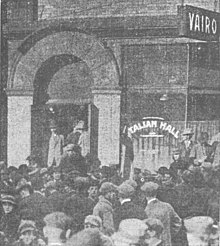Italian Hall
Italian Hall was a two-story commercial and recreational building in Calumet, Michigan, built in 1908 and demolished in 1984.
The building served as headquarters for the Società Mutua Beneficenza Italiana (Italian Mutual Benefit Society) and hosted community events.
The hall is notorious as the site of a disaster in 1913 in which over 70 people died after a false cry of "fire" at a Christmas party.
[7] On the main wall was a cast metal cornice, bearing the words Societa Mutua Beneficenza Italiana, supported at either end by pilasters topped with Doric capitals.
On April 5, 1913, the northern space was let to The Great Atlantic & Pacific Tea Company and remained in that use through at least the end of the year.
[10] At the time of the 1913 disaster, the southern space was occupied by a saloon owned by Dominic Vairo; the original tenants are unknown.
[10][11] At the south end of the building's front was a doorway, framed by brick pilasters, with capitals and imposts supporting an arched overdoor all made of Jacobsville Sandstone.
[12] Straight ahead was a set of double doors separating it from a 5.75-foot-wide staircase (1.75 m) that led up to an 8-by-10-foot (2.4 by 3.0 m) vestibule that opened to the hall on the second floor 38 feet (12 m) from the front of the building.
The dedication speech was written by James MacNaughton, the general manager of the Calumet and Hecla Mining Company, but, due to a family death, he could not attend and it was read by someone else.
[10] On December 24, 1913, a Christmas party for the children of strikers was arranged by Anna Clemenc and the Women's Auxiliary of the WFM and held at Italian Hall.
[19] Even though there was no fire,[8] they rushed down the staircase in an attempt to escape and those at the bottom suffocated under the crush of people.
[3][6][a] The disaster was reported in such newspapers as The New York Times,[21] the Boston Daily Globe,[23] The Atlanta Constitution,[24] The Evening Independent of St. Petersburg, Florida,[25] and The Toronto World.
[4] In 1980, the building received threats of condemnation from the village for its unsafe condition and its owner, Helen Smith, was incapable of maintaining it.
[27] As of 2010[update], the park consisted primarily of the doorway arch and a few historic markers set in the middle of the lot.
[20] In the rear, a Michigan Women's Hall of Fame marker about Anna Clemenc once stood, but it was removed at some point.
[37] In 2017, work began to add a monument at the site listing the names of the people who died in the 1913 disaster.
[39][40][41] Installation of the monument was originally planned for November 2017,[42] but brown-colored defects were found in the stone and it was rejected.



